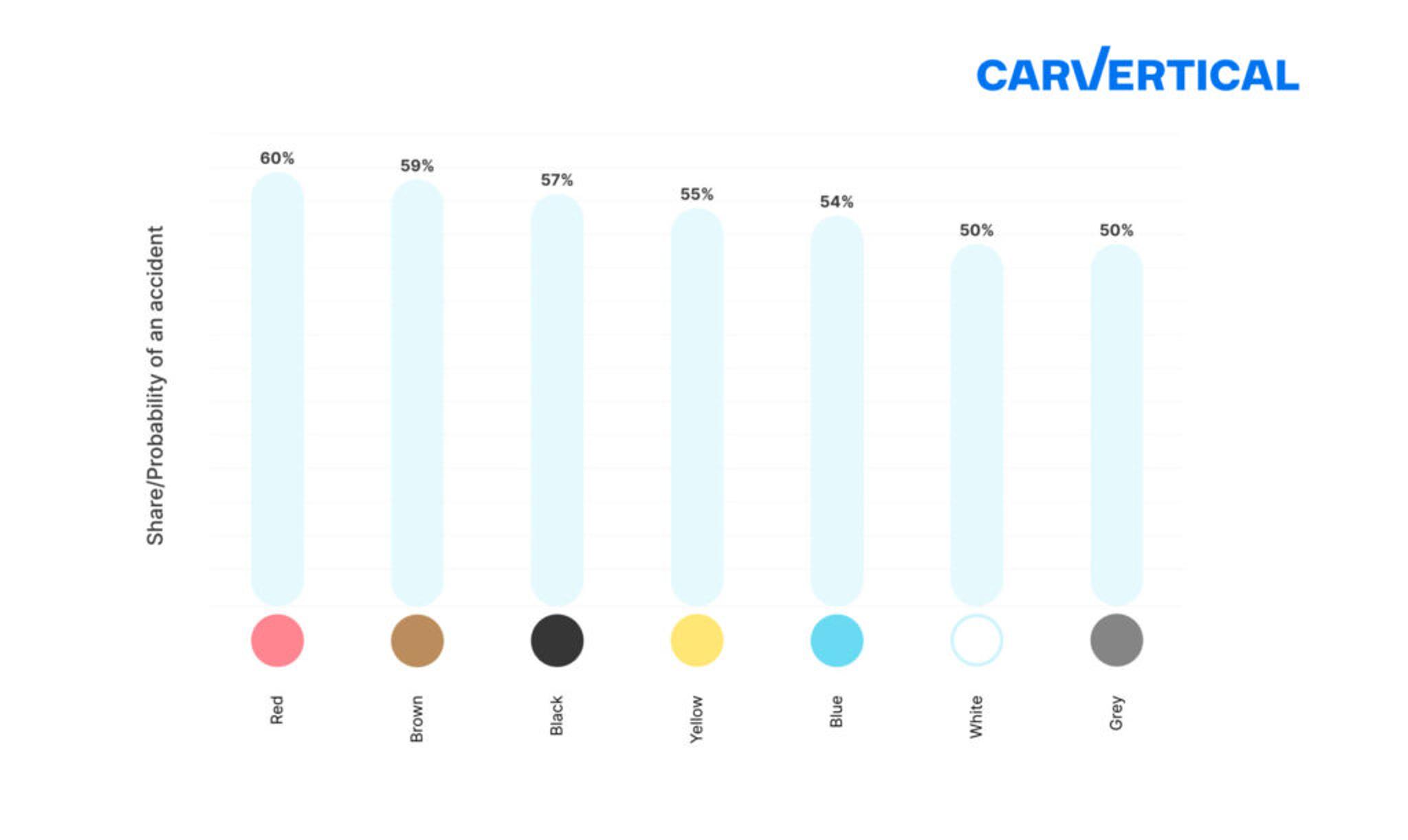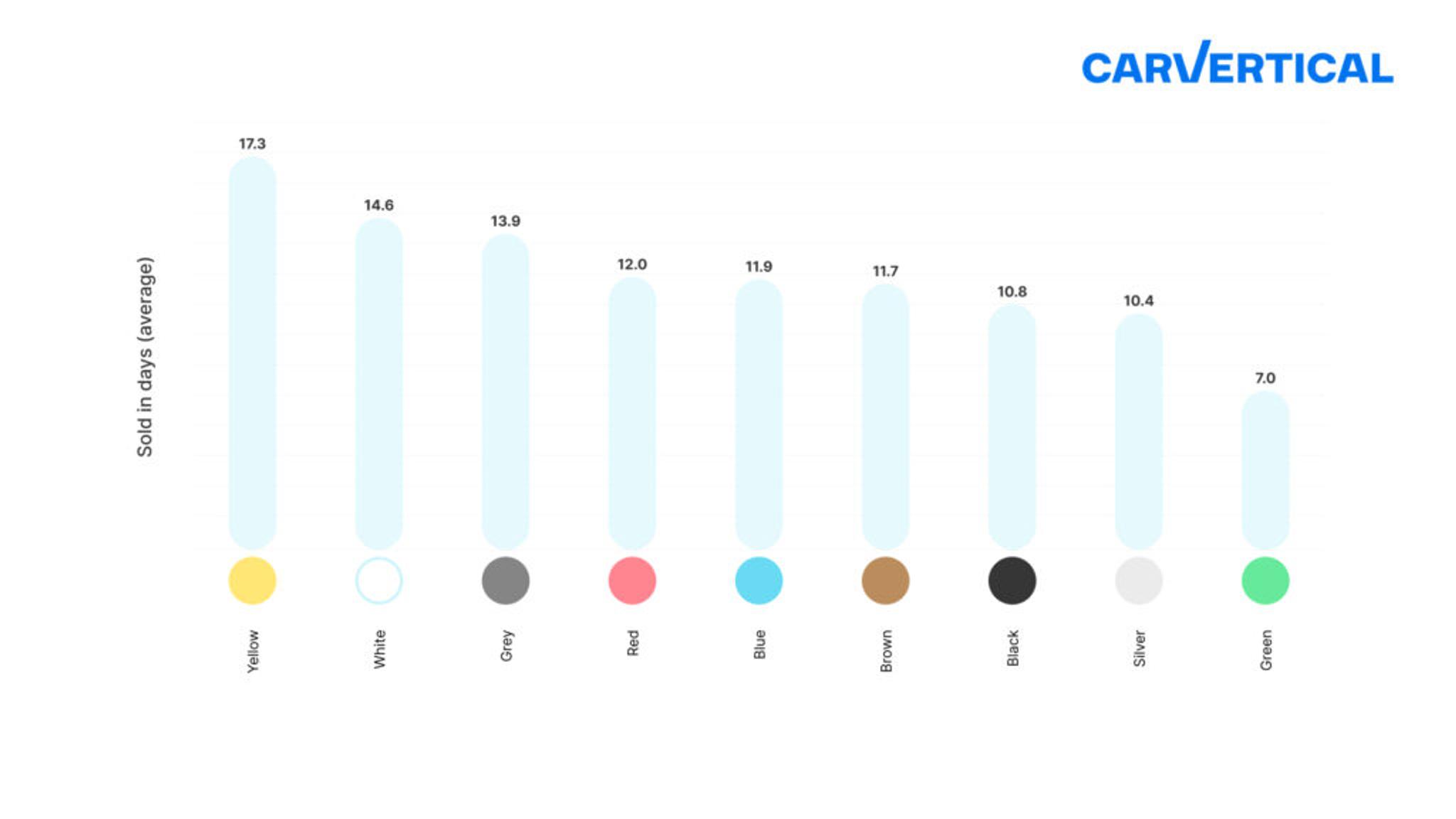16/09/2022
Research: Car colors and why they matter

Karolis Bareckas

While car colors are widely perceived as personal preference, they may be more significant than you think.
Our team has collected data from vehicle history reports to see what it can teach us about used car colors. Which are the most popular and where? How have drivers' preferences changed over time? And most importantly, do colors have a measurable impact on a car’s safety and liquidity?
While we couldn't find proof that insurance companies charge more for red cars (as many have suspected), we did learn quite a few interesting facts!

Afraid of buying a wreck?
Check any VIN to learn a vehicle's history!
Which car colors are the most popular?
If you look around on the street, you will immediately notice that some car colors are more popular than others. However, vehicle color trends vary from country to country. A color desired in Poland may not be that popular in Portugal or Mexico.
There are more colorful vehicles in countries with warm climates compared to colder countries. You won’t see a bright car in Norway, Canada, or Sweden often, but the situation is quite different in California or Italy.
As a general rule, white cars are more popular in warmer climates, because white reflects sunlight, making these cars less hot to drive.

Our study has revealed that white is the most popular color in Australia (39.1% of the total vehicle fleet) and the EU (26.8%). Australians also adore silver (15.9%) and gray cars (14%). Europeans prefer gray even more (25.9%), followed by black vehicles (24.5%).
A similar percentage of black vehicles can also be found in the US (24.7%). However, they also like white (20.9%) and silver (17.3%) cars.
71% of cars checked on our platform were black, white, gray, or silver. This only proves that people are pretty conservative when it comes to vehicle color.
Have we always loved the same colors?

Vehicle interior and exterior trends have changed significantly throughout the years. And so have the most popular car colors. For instance, 42% of cars manufactured in 2002 and checked on the carVertical platform were gray or silver. However, there were not so many white vehicles at that time.
Out of all the cars made in 2020 that were checked, 26% were gray and 18% – white.
Some colors – like black – stand the test of time better than others, as the share of black cars between 2002 and 2020 has remained more or less similar. Sometimes, color trends last only a few years. For example, the number of brown cars grew between 2012 and 2014 but then it started to plummet in upcoming years.
Do car manufacturers prefer specific colors?
A specific color can be a part of a manufacturer’s identity and branding. Red is associated with Ferrari, yellow – with Lamborghini, blue – with Subaru, etc. However, most people are more conservative and manufacturers know that.
Let’s take Audi as an example. Out of all Audis checked on carVertical over a several year span, 37.5% were black, 31.3% – gray, and 10% – white, which represents the current vehicle color trends quite well.
Black is also the most popular selection among BMW customers – 35% and Mercedes-Benz – 36%. Gray is the most popular color in Škoda – 32.75%, Toyota – 34.3%, Volvo – 31%, Opel – 32%, and Volkswagen cars – 33.6%. While it’s possible to purchase a Volkswagen or Mercedes in a bright color, this is a rare choice, and customers prefer time-tested tones.
Some manufacturers like Peugeot or Citroen have introduced bright colors to their palettes throughout the years, which attract younger and more extroverted drivers. However, gray, white, and black are still much more popular among their customers than blue or yellow.
Are some car colors safer than others?

It may come as a surprise, but some car colors are more likely to suffer an accident. According to carVertical research, red is the most dangerous color, as 60% of vehicles checked on our platform have been in an accident.
Speed fans love sports cars and they adore red. Brown (59%) and black (57%) cars are also relatively more dangerous. Yellow (55%) and blue (54%) are less so, whereas white (50%) and gray (50%) are the safest.
While many cars will suffer minor or severe damages throughout their lifetime, if data is to be trusted, you can mitigate the risk of ending up in a crash by choosing white or gray. In reality, this, again, probably tells us more about the kind of cars that come in bright colors and their drivers, than it does about the colors themselves.
As a matter of fact, research (and common sense) suggests that bright cars are more visible on the road than gray or silver cars, whose color looks much like the road.
Is it easier to sell some colors?

In short, yes. According to our data, it only takes 7 days on average to sell a green car, making it stand out among other colors. Usually, drivers aiming for less popular colors like green already know what they’re looking for and prioritize a vehicle’s exterior over technical characteristics.
People selling silver and black cars also won’t have to wait long for a buyer, as it takes only 10.4 and 10.8 days respectively to get a bargain on vehicles painted in these colors.
Let’s take the BMW 5 Series as an example, one of the most checked models on carVertical, which can provide valuable insight into this topic. It takes 7.9 days to sell a green 5 Series, 10.9 days – black, and 11.5 days – blue.
Car colors to avoid if you want a quick sale
While yellow cars are rare, owning one may not be the best idea, as you will have problems selling it. According to our study, it takes 17.3 days to sell a yellow car. White (14.6 days) and gray (13.9 days) vehicles are also harder to sell.
Why aren't buyers interested in yellow cars? When it comes to sedans, SUVs, or hatchbacks, yellow is not a common color and drivers prefer more conservative choices. Yellow is mostly used in sports cars and other extravagant vehicles with a very limited circle of buyers.
Let’s analyze the BMW 5 Series even further. Our research indicates that it takes the most time to sell a white 5 Series (14.2 days). BMW drivers love speed and style, suggesting white may not represent their personality traits. A 5 Series in gray (13.9 days) and red (13.7 days) are also not the most popular colors among used car buyers.
It’s also no surprise that some car colors depreciate faster than others. Bold colors, such as yellow, red, and orange hold their value better than white, black, or gray ones. These colors are mostly used in exotic cars that usually depreciate slower.
While picking a car in your favorite color may seem trivial, there’s a whole science behind this simple action. Next time you’re going to look for a used vehicle, make sure you know its peculiar advantages and disadvantages. Otherwise, it may cause you some unforeseen troubles!

Check your VIN
Avoid costly problems by checking a vehicle's history. Get a report instantly!

Article by
Karolis Bareckas
Karolis is an automotive writer focusing on the industry part of things. His goal is to educate readers and foster transparency in the used car market. With a passion for storytelling and extensive experience writing in a variety of fields, Karolis enjoys sharing his knowledge and spreading the word about automotive and tech topics. He’s also a a big fan of muscle cars and long road trips.
